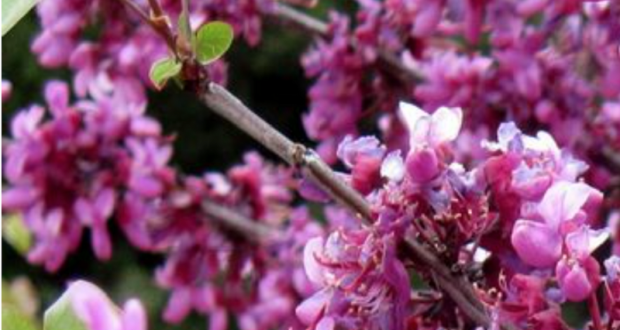By Ron Allen, UC Master Gardener, Mariposa County
Although autumn is generally the best time to add native plants to your landscape, spring is the next best time.
Choosing a planting site is important. Fire-prone plants such as manzanitas, pines and plants with resinous leaves and stems should be located well away from structures. Toyon and Redbud are fire-resistant, look good year round, and attract wildlife. It’s feasible to situate them near but at least five feet from structures. A few low-water native plants—Cleveland Sage, Flannel Bush, California Fuchsia, California Poppy, or Deergrass—can be planted within an oak tree’s drip zone, as long as they are more than six feet from the trunk.
Digging an hole in springtime is easy; the ground is moist. Dig a hole roughly twice the volume of the container. A square hole encourages the plant’s roots to grow downward and not circle the hole. It should be a few inches deeper than the level of the dirt around the plant in its bucket.
Even plants that are typically gopher-resistant may not be so when young. Thus, if the spot has gophers, it’s prudent to insert a gopher screen made of ½” hardware cloth. The screen should extend a few inches above the soil surface to prevent gophers from accessing the plant above ground.
Fill the hole with the loose native soil to the depth of the pot. Gently draw the plant out of the container over the hole. If the plant is stuck, run an old kitchen knife around the inside of the container. Add or remove underlying soil as necessary to keep the plant at the same soil level as it was in the pot. Refill the hole around the plant with the native soil. Do not add soil amendments. Water thoroughly to eliminate air gaps in the soil.
In spring, weeds will try to crowd out your native plant. A flat rock or two or a layer of gravel over the filled hole can help. You could mulch with a layer of cardboard and a 3-4” layer of pine or oak chips, but keep the mulch away from the plant stem to prevent fungal decay. Pull weeds when they are small. If the weeds get larger, cut them off with garden shears to avoid disturbing the sensitive roots of your new native plant.
Planting in spring gives less time to establish roots as one planted in the fall. Compensate for this by watering through the first spring and summer at a rate of one gallon per week while the ground is dry.
UC Master Gardeners of Mariposa County serve Mariposa County, including Coulterville, Greeley Hill and Don Pedro. For gardening and event information, call us at 209-966-7078 or email mgmariposa@ucdavis.edu. Find us online at http://cemariopsa.ucanr.edu/Master_Gardener/, on Facebook (UC Master Gardeners of Mariposa County), and on YouTube at “UCCE Mariposa.” Listen to us on KRYZ 98.5 FM radio Wednesdays at 2 p.m. and Saturdays at 5 p.m.




